I’ve been working as a professional travel photographer for the past 7 years. During this time, I’ve shot for national tourism boards and world-leading photography brands like Manfrotto and LowePro.
But, it’s been a long road to get to where I am today. I’ve been traveling and taking photos as a hobby since 2015, funding my way around the world by working online jobs, while obsessively sharpening my skills through constant practice on the road.
While practice is more important than gear, choosing the right camera kit is undeniably the most important first step for beginners.
So, to help you kickstart your journey, I’ve compiled this comprehensive guide to choosing the best travel photography gear. Whether it’s your dream to become a pro travel photographer, or perhaps you just want to find a good camera for your next vacation, this guide will cover all budgets and photography styles.
Video: My Current Travel Photography Setup
Below is a quick video showing my current photography gear setup that I carry around the world. This is a good showcase of some of the good features of my current favorite camera backpack for hiking & travel: the Atlas Adventure.
What's New For Travel Camera Gear in 2025?
I update this guide every year to make sure you're getting the most accurate, no-fluff recommendations to help you pick the right gear for your travels, not just what’s trending on TikTok.
Let’s get one thing straight: the fundamentals haven’t changed. If you’re here looking for the “best camera” and your plan is to post shaky phone videos with pastel presets, you might be on the wrong page (no offense, influencer crowd, you’re doing great).
But if you're a traveler who actually wants to capture real moments, shoot epic destinations properly, and maybe even build a portfolio or get brand work, this gear list is for you.
A quick note on AI: Yes, AI image generation is everywhere now, but it’s not taking over travel photography just yet. You can’t fake standing on top of a Himalayan ridge at sunrise. Resorts still need real content. Tourism boards aren’t commissioning Midjourney renders of Maldives beaches (yet). Travel photography remains one of the last frontiers of authentic visual storytelling, and that’s why having solid travel photography equipment still matters.
What's New in My 2025 Gear Recommendations:
- GoPro Hero 13 Black replaces the Hero 11 — better image sensor, upgraded stabilization, and GP-Log video make this a no-brainer for action shots.
- Sony RX100 VII replaces the Panasonic Lumix TZ220. Yeah it's old but still no true successor. I still think it’s the best compact alternative available in 2025 with excellent image quality and zoom in a pocketable size.
- Sony ZV-E10 II replaces the original ZV-E10. Same compact size, now with improved autofocus, better heat handling, and sharper 4K video for hybrid shooters.
- Canon R5 II replaces the original R5. Updated autofocus and improved battery life make this the best pro-grade mirrorless I've used, especially for travel work.
- As usual, new drones from DJI (latest recommendations and which to skip below...).
Designing a Photography Kit For Travel
You don’t need a bag full of gear to take great photos. For some, a GoPro or Insta360 is all you’ll ever need. But if you’re serious about capturing quality travel photos and videos whether you're just starting out or looking to level up, it helps to build a proper kit around your camera.
Your camera is the foundation. Every lens, drone, or accessory you add needs to match the system you choose. And with the explosion of compact mirrorless and MFT cameras, the options are endless and often overwhelming.
That’s why I’ve narrowed it down to what actually works. Below you’ll find the complete travel photography kit I use daily, along with updated recommendations for 2025. It covers every category:
- Camera
- Lenses
- Drone
- Action/360 Camera
- Essential Accessories
- (Optional) Tripod

1. The Best Cameras for Travel
Best beginner camera: Sony ZV-E10 II
What I use: Canon R5
| Camera | Type | Price |
|---|---|---|
| GoPro Hero 13 Black | Action | $ |
| Sony RX100 VII | Compact | $$ |
| Olympus OM-D E-M10 Mark IV | Micro Four Thirds | $$ |
| Sony ZV-E10 II | Mirrorless (APS-C) | $$ |
| Sony A7IV | Mirrorless (Full Frame) | $$$ |
| Canon R5 II | Mirrorless (Full Frame) | $$$$ |
GoPro Hero 13 Black
Years ago, there's no way I would’ve recommended an action camera as a serious tool for travel photography. But these days? They’re pretty darn good. I’m still not a huge fan of the "action cam look", that super-wide, slightly distorted view doesn’t suit every scene.
But for travel video, it’s hard to beat what these things can do in such a tiny body.
The GoPro Hero 13 Black is the latest in the world’s most popular action camera line and it’s still the best tool for capturing fast-paced, hands-free content on the move. While it’s marketed mainly at the action-sports crowd, GoPros have become an essential part of many travel photography kits thanks to their rugged design, ultra-wide lens, and reliable video quality.
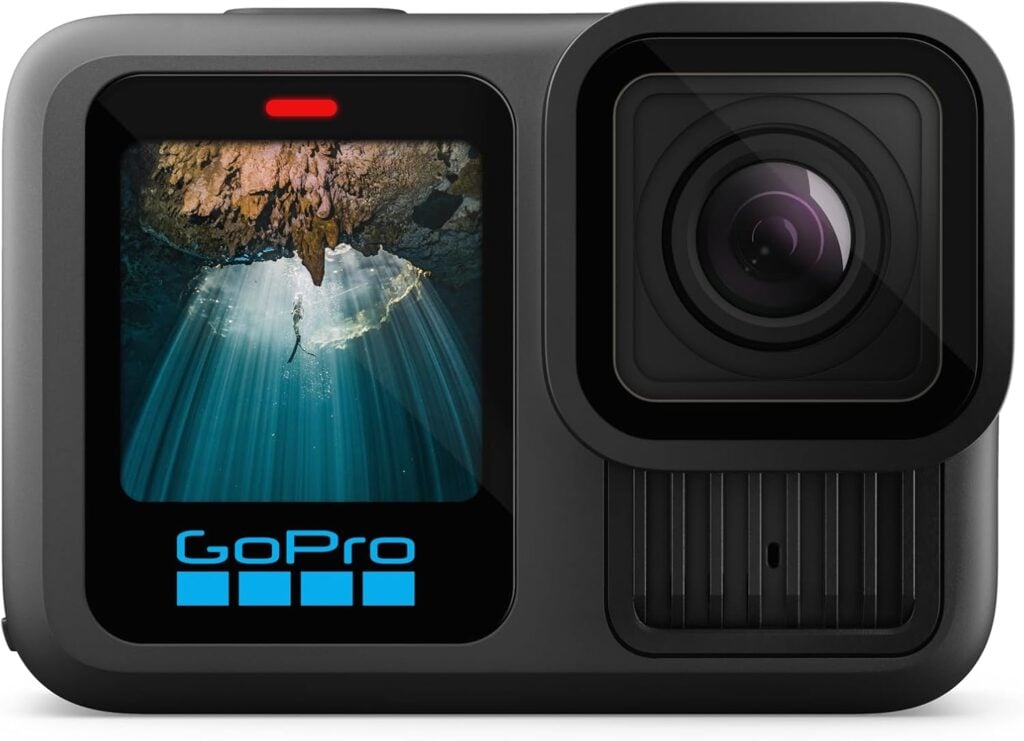
The Hero 13 continues to improve on both image quality and video performance, now offering better low-light capabilities, 5.3K video at 60p, 4K at 120p, and GoPro’s excellent Hypersmooth 6.0 stabilization. It even has GP-Log and 10-bit color, which gives you more flexibility in post if you’re editing.
Even for stills, GoPros can surprise you. You won’t get pro-grade depth of field or full dynamic range, but if you shoot in good light, frame your scene properly, and use the SuperPhoto mode or RAW, the results can actually be impressive, especially for something you can clip to your chest or helmet.
Pros:
- Tiny, rugged, and waterproof — great for underwater, boats, or mountain shoots
- Incredible Hypersmooth 6.0 stabilization
- 5.3K 60p and 4K 120p video modes
- Front + rear LCDs make it easy to vlog or frame yourself
- Upgraded low-light and dynamic range performance
- 10-bit color with GP-Log for video editors
- Bluetooth audio support & easy voice control
Cons:
- Small sensor that's still not great for low-light stills
- Short battery life (though improved)
- Touchscreen can lag when wet or cold
- Wide angle isn’t for everyone. Not ideal for portraits or controlled compositions
Best for: Travelers who want an easy, rugged camera for action and video. Great for hiking, diving, and rough conditions. Not a main camera, but perfect for capturing scenes your big setup can’t.
Sony RX100 VII
The Sony RX100 VII is still the king of premium compact travel cameras, even six years after release. Despite its age, nothing has really dethroned it when it comes to packing serious performance into a pocket-sized body. It’s got a 1-inch stacked CMOS sensor, a sharp 24–200mm equivalent zoom lens, and Sony’s reliable real-time autofocus tracking, all in a camera that weighs under 300g.
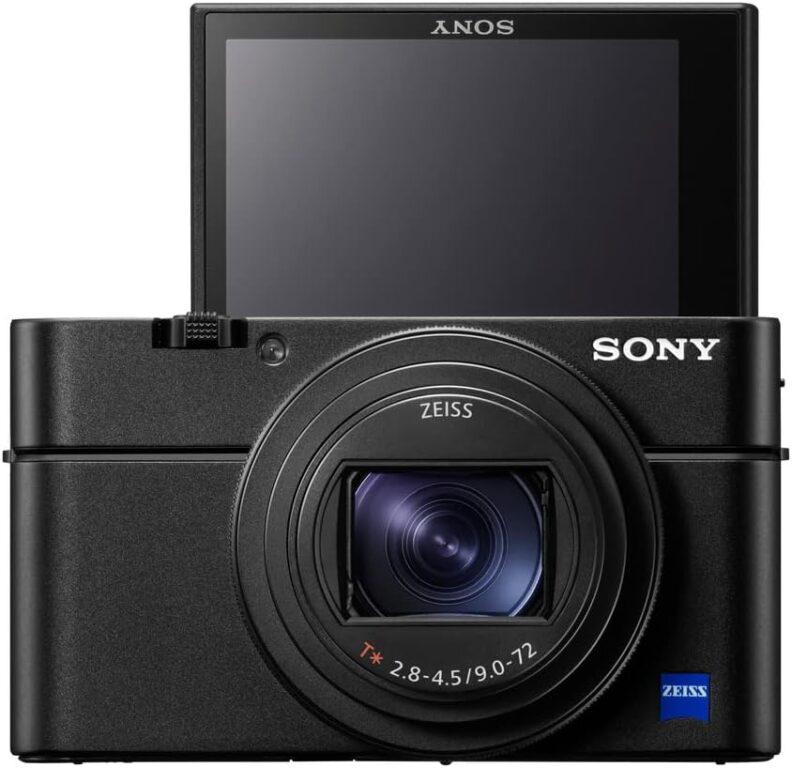
This is the kind of camera you can throw in your pocket for a city walk, use for sneaky street shots, or pull out for a quick landscape without fiddling with lenses. It’s also one of the best “stealth” cameras out there for travel, especially if you’re somewhere you don’t want to draw attention with a full mirrorless setup.
It shoots great stills and solid 4K video, though low light is its biggest limitation. You also won’t get that depth-of-field look that larger sensors provide. Still, for many travelers, this might be the only camera they need.
Pros:
- Compact and lightweight — true pocket camera
- Great 24–200mm f/2.8–4.5 zoom lens
- Fast real-time AF with subject tracking
- Good image quality in daylight
- 4K video with mic input
- Pop-up EVF and flip-up screen
Cons:
- No in-body stabilization for stills
- Mediocre low-light performance
- Tiny controls can feel cramped
- Still expensive for an older camera
Best for: Travelers who want a compact, all-in-one camera without compromising too much on quality. Perfect if you don’t want to carry lenses or just need a reliable backup to your main kit. Still one of the best point-and-shoot options for travel photography in 2025.
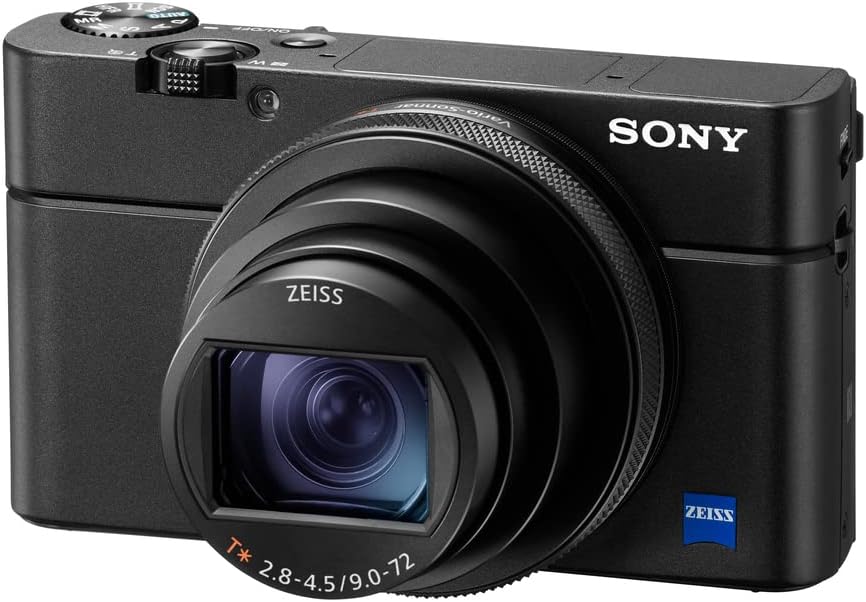
Olympus OM-D E-M10 Mark IV
The Olympus OM-D E-M10 Mark IV is a 20-megapixel micro four-thirds camera with 5-axis in-built image stabilization and includes a great range of high-quality compact lenses.
This is the entry-level camera in Olympus' micro four-thirds range of compact DSLR-style cameras. However, I believe that it's the best option in this price range with all the features you'll want in a low-budget interchangeable lens camera for travel.

Pros:
- Great camera form factor for travel
- Great in-built stabilization
- Flip-display
- 4K 30p video
- USB Charging (don't need to carry additional chargers)
- Wifi + Bluetooth
- Decent battery life
- Loads of great lenses to choose from
Cons:
- Contrast-detect AF system isn't as good as a Dual-pixel or hybrid
- No mic/headphone input
- Slow 5fps max shutter
Best for: Olympus is a great entry-level camera for travel photography serving as a perfect platform to learn and grow as a photographer.

Sony ZV-E10 II
The Sony ZV-E10 II is the long-awaited successor to the original ZV-E10 — and it’s now my most recommended camera for beginner travel photographers. Sony kept everything that made the first version great, and improved it where it counts: better autofocus, sharper 4K video, updated color science, and improved heat management.
It’s a compact mirrorless camera with interchangeable lenses, making it a great entry point into “real” photography while still being super capable for video. The flip screen, headphone and mic jacks, and USB-C charging all make this a great hybrid shooter.

What really sets it apart is that you can grow into it. Pair it with the kit lens to start, then slowly add a wide-angle or telephoto when you're ready. It’s budget-friendly, flexible, and actually fun to use.
Pros:
- Excellent autofocus with subject tracking
- 4K 60p video and improved color profile
- Compact and lightweight
- USB-C charging and livestream/webcam support
- Flip screen + mic/headphone jacks
- Great lens ecosystem to build on
Cons:
- No in-body stabilization
- Still uses a rolling shutter in video
- No EVF (viewfinder)
- Plastic build — not weather-sealed
Best for: Beginner travel photographers or creators who want to level up from a smartphone without diving into pro gear. The ZV-E10 II is compact, affordable, and futureproof enough to grow with you.
The main downfall for me is that due to the small size, it is a little more difficult to use the buttons and controls than compared to some of the larger, pro models below.

Sony Alpha A7IV
These last two camera bodies see us step up into the pro-level travel photography gear. The Sony A7IV is a big step up from the super popular A7III, which I used to recommend in this constantly updated article for several years.
This updated model is easily one of the best-performing full-frame mirrorless cameras on the market and more than capable as an excellent full-frame camera for travel.

Pros:
- Great full-frame image quality
- 94% autofocus coverage with great performance
- In-body image stabilization
- Many excellent lenses to pair with
- Dual SD card slots
- Oversampled 4k 60p video recording capability
- Great size for a full-frame camera
- Best bang-for-buck camera on the market
Cons:
- Weather sealing is not as good as competitors
- Need a fast card for video performance
- Slow max shooting speeds
Best for: The Sony A7IV came in very close to taking the top spot for the best camera for travel photography. While it's a little pricey, Sony certainly offers great value for money through excellent performance and great features that make it the perfect camera for pros or those really serious about travel photography.
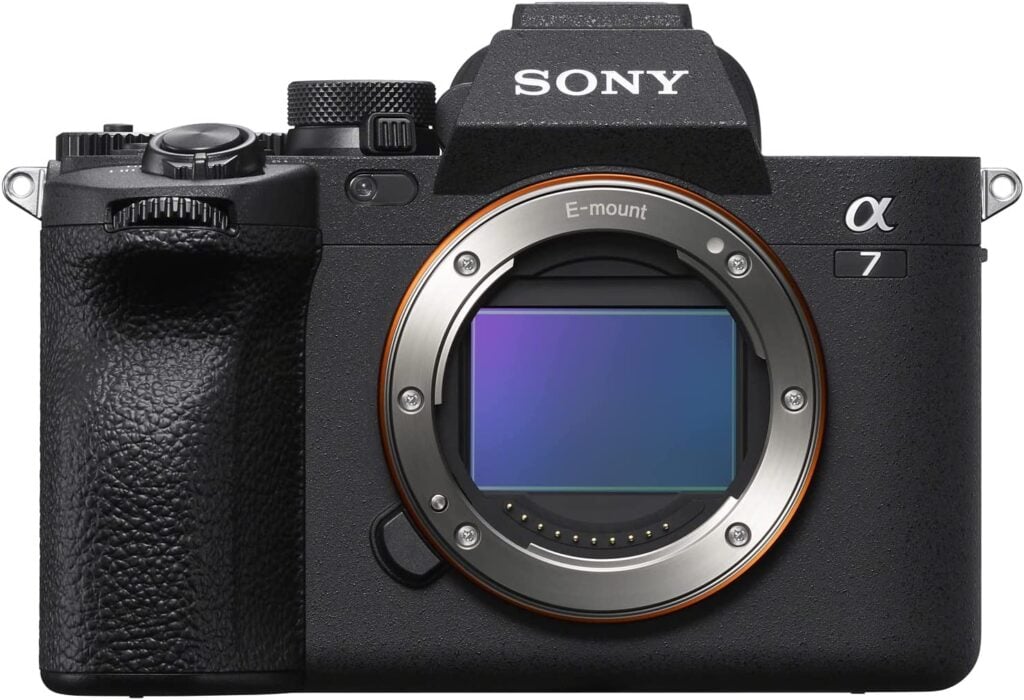
Canon EOS R5 II
I used the original Canon R5 for over five years, and honestly, most of the photos on this website were taken with that camera. It’s been an absolute workhorse, reliable, fast, and with image quality that still holds up today. I’ve said it before and I’ll say it again: the R5 was, in my opinion, the best camera ever made… until the R5 II came out.
Canon’s new R5 II brings a few nice upgrades: better autofocus (especially subject recognition and tracking), improved heat handling for video, slightly better battery life, and a higher-res EVF. The sensor remains 45MP, but with improved dynamic range and readout speeds. There's also a new multi-function hot shoe and updated image processor.

But here’s the truth, the improvements are mostly incremental. Aside from the better video performance and autofocus tracking, there's not a huge leap from the original R5. That’s why I still haven’t upgraded. For me, there's just not enough reason to make the switch yet.
That said, if you're buying new in 2025, there's no question, get the R5 II. It refines what was already a near-perfect camera and sets the bar again for high-end travel photography and hybrid shooting.
Pros:
- 45MP full-frame sensor with better dynamic range
- Improved AF and subject tracking (especially birds/animals)
- No overheating in 8K and 4K HQ modes
- Upgraded EVF and LCD
- Excellent IBIS and Canon color science
- Dual card slots (CFexpress + SD)
- New image processor and better buffer performance
Cons:
- Expensive
- CF Express cards are expensive (required to shoot in 8k)
- RF Lenses are expensive
- Still no built-in fan (limits extended pro video use)
- Minor upgrades if you're coming from the R5
Best for: Pro-level travel photographers and hybrid shooters who want top-tier stills and video in one body. If you're buying fresh in 2025, the R5 II is one of the best all-around cameras ever made, just know it's overkill unless you’re using it to its full potential.

Related: Essential Digital Nomad Packing List
2. Best Lenses for Travel Photography
The next step in choosing your travel photography gear list is a lens or two to match your camera of choice. The truth is, there are way too many options to list and review for every camera body out there.
However, for travel photography especially, it's best to go for zoom lenses over primes. This will give you a more flexible focal range without doubling up or needing a whole bag of lenses for different shoot types.
To achieve good coverage of lenses for all shoots, consider purchasing:
- A good walk-around lens - a versatile lens for portraits, shots of people, landscapes, food, buildings, landscapes, etc.
- A wide-angle lens or ultra-wide - for landscapes, astrophotography, and architecture
- A telephoto lens - for wildlife and unique perspectives in landscapes (think blown up mountain backdrops)
A Walk-Around Lens (Kit Lens)
A walk-around or general kit lens is a versatile lens that photographers use for a wide range of subjects and shoots. The focal range will depend on the sensor size of your camera but usually covers the fairly wide to near telephoto focal range.
This is typically the type of lens that travel photographers use most. However, this varies depending on the style of photography you like. For example, I tend to shoot a lot more landscapes so I actually end up using my wide-angle lens more often.
Best option for the Sony ZV-E10 II: Sony 16-70mm f/4
What I use: Canon RF 24-105 f4L USM IS for the Canon R5 II (cheaper and lighter than the better 24-70mm f2.8L)
| Camera | Lens | Buy |
|---|---|---|
| Sony RX100 VII | N/A | N/A |
| Olympus OM-D E-M10 Mark IV | Olympus 12-45mm f/4 | Amazon |
| Sony ZV-E10 | Sony 16-70mm f/4 | Amazon |
| Sony A7IV | Sony FE 24-105mm F4 | Amazon |
| Canon R5 | Canon RF 24-70mm f2.8L | Amazon |



Wide Angle Lens
For my style of travel photography, a wide or ultra-wide lens is the most fun and captivating focal range to use. Wides and ultra-wides fit an entire scene into the frame, which is great for landscape vistas, action shots, night photography, and busy streets.
Below I've listed the best wide-angle lenses for travel photography for each camera. Note that again, all but one are zoom lenses, allowing them to be more versatile. The Rokinon for the Olympus is a prime, but a great one that shouldn't be passed up if this is the camera you go for.
Best option for the Sony ZV-E10: Sony 10-18mm f/4
What I use: Canon RF 15-35mm f2.8L IS USM
| Camera | Lens | Buy |
|---|---|---|
| Sony RX100 VII | N/A | N/A |
| Olympus OM-D E-M10 Mark IV | Rokinon 12mm f/2.0 NCS CS | Amazon |
| Sony ZV-E10 II | Sony 10-18mm f/4 | Amazon |
| Sony A7IV | Sony FE 16-35mm F2.8 GM | Amazon |
| Canon R5 | Canon RF 15-35mm f2.8L IS USM | Amazon |


Optional: A Telephoto Lens
Telephotos aren't a necessary lens focal length for many travel photographers. Due to their large size and limited use cases, many seem to pass them up to save room in their travel photography gear bags.
However, I've recently started shooting with a super-telephoto by Canon and I absolutely love the unique shots that I'm able to get with it. For landscapes, you can get incredible blown-up backgrounds of mountains, city skylines, or even the moon or setting sun. I also love using a telephoto for wildlife photography, allowing beautiful, up-close photos without needing to get too close to the subject.
Best option for the Sony ZV-E10 II: Sony FE 70-300mm f/4.5-5.6 G OSS
What I use: Canon RF 100-500mm f4.5-7.1L IS USM
| Camera | Lens | Buy |
|---|---|---|
| Sony RX100 VII | N/A | N/A |
| Olympus OM-D E-M10 Mark IV | Olympus 12-200mm f/3.5-6.3 | Amazon |
| Sony ZV-E10 II | Sony FE 70-300mm f/4.5-5.6 | Amazon |
| Sony A7IV | Sony FE 100-400mm f/4.5-5.6 | Amazon |
| Canon R5 | Canon RF 100-500mm f4.507.1L | Amazon |



Related: Finding the Best Portable SSD for Photography
3. Best Drone For Aerial Travel Photography
Drones have absolutely changed the game! I consider them one of the most useful bits of travel camera gear in my kit. More often than not, my favorite shot from a particular shoot will end up being captured from my drone. The unique perspectives are just too good to pass up.
Below are the current best drones for travel photography.
| Weight | Camera | Price | |
|---|---|---|---|
| DJI Mavic 4 Pro | 958 g | Wide-Angle: 4/3" CMOS, 100MP Medium Telephoto: 1/1.3" CMOS, 48MP Telephoto: 1/1.5" CMOS, 50MP | $$$$$ |
| DJI Air 3S | 724 g | Wide-Angle: 1" CMOS, 50MP Medium Tele: 1/1.3" CMOS, 48MP | $$$ |
| DJI Mini 4 Pro | <249 g | 1/1.3" CMOS, 48MP | $$ |
Please note: The Mini 4 Pro's max flight time is with a plus battery, so if you're planning on flying for extended periods, it's worth investing in that extra battery, otherwise, the flight time will be 34 minutes.



DJI Mavic 4 Pro
I’m still using the Mavic 3, it’s been rock-solid for years, and while the Mavic 4 Pro is undeniably impressive, the upgrades haven’t quite been enough for me to swap just yet.
That said, the new triple-camera setup is seriously tempting. The main 4/3" Hasselblad sensor is back, but now there’s a sharper medium tele lens alongside the long telephoto. I can definitely see the 70mm equivalent lens being a game-changer for mountain and alpine photography, letting you compress peaks or isolate details from way off.
If you’re buying new, and want pro-level drone shots with real versatility, this is the one to get.
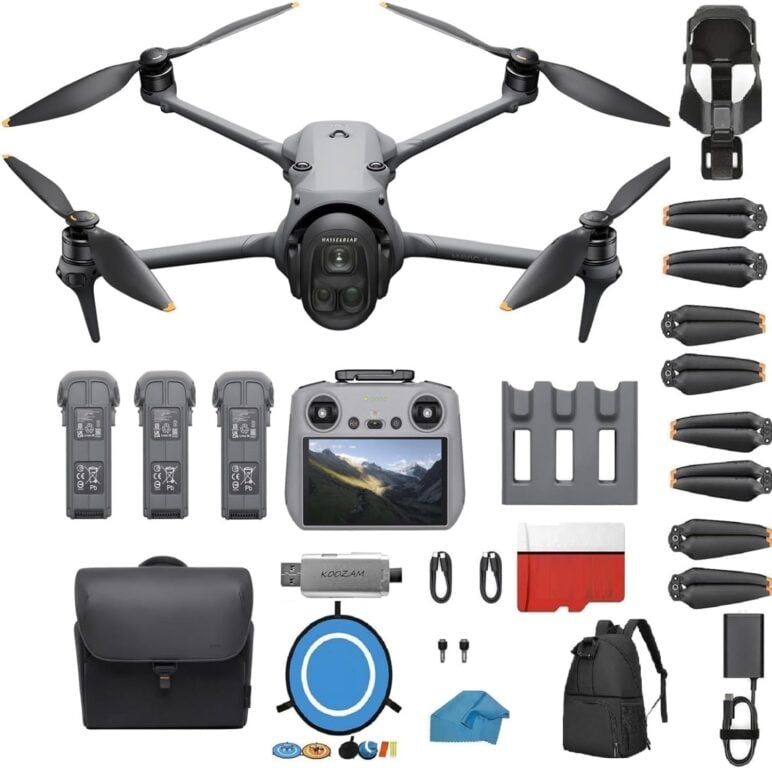
Related:
3 Types of Filters You Need for Your DJI Drone
DJI Mavic Air 3S
The DJI Air 3S is one of the best all-round travel drones out right now, especially for adventure photographers who want pro-level quality without hauling a flying tank. It’s a solid upgrade from the Air 3, with a new 1" main sensor for sharper stills and better low-light performance, plus a refined dual-lens setup that includes a versatile medium telephoto.
I personally know quite a few high-level travel photographers who shoot with this drone full-time, especially those working in adventure travel. It’s light, fast to deploy, and delivers stunning images that easily hold up for commercial use. If you want something more capable than a Mini but not as bulky as a Mavic 4 Pro, this is the sweet spot.

DJI Mini 4 Pro
For amateur or enthusiast photographers looking to get into aerial photography on their travels, the DJI Mini 4 Pro is going to be the drone for you. This thing is tiny and weighs less than 250 grams (8.5 oz) which makes legislation rules much easier to comply with when traveling.
Additionally, it folds down to the size of a Coke can, which is perfect for travel.
Unlike previous versions of the Mini range, the Mavic Mini 4 actually packs in a great camera! You'll get great 4K/60p video (up to 4K/100p) and 48 MP stills!

4. Choosing an Action/360 Camera For Travel
Another great piece of camera gear for travel is an action camera. For some, you could easily skip this. For others, you might choose to replace your entire kit with a single, tiny, high-performing camera.
Personally, I'm a big fan of action cameras like GoPros. Similarly to drones, they've changed the game in travel and adventure photography. They allow photographers to get insane perspectives and capture quite good images and video with a camera that fits in your pocket.
Recently, the industry is changing once again. With the introduction of high-quality 360 cameras, many like myself will end up replacing their traditional GoPros with 360 cameras since they do it all, with the ability to create awesome, 360 images and video.
Below I'll include the best action cameras for travel for you to consider.

GoPro Hero 13
The GoPro Hero range is the most-sold camera in history. And, the Hero 13 is the best yet. I already gave you a run down of these above, so I won't repeat myself here.

Insta360 One X4
A few years back I traded in my GoPro for the Insta360 One X3. These days, there's a new version on the block. The Insta360 One X4 is a step up from previous models and still some of the funnest pieces of equipment I've used in years.
The newer X4 features 8K 360° video, better stabilization, improved low-light performance, and longer battery life.
What makes it great for travel photography is how easy it is to get dynamic, immersive shots without needing to worry about framing. You just hit record and decide on the angle later in post. It’s compact, waterproof (but I've broken one in shallow water, best get the dive case), and versatile enough to mount anywhere.
I've even used this tiny camera to make professional 360-room tours for hotels!
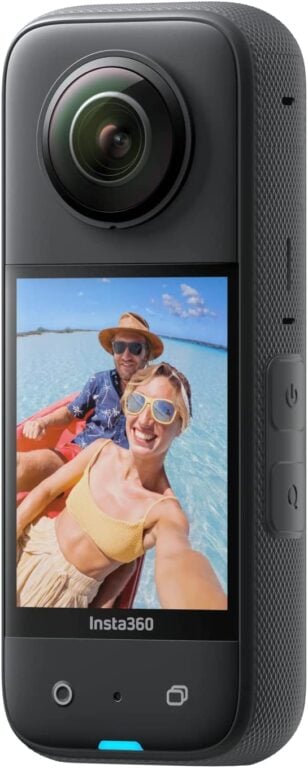
5. Essential Camera Accessories For Travel
By now, you'll probably have quite the shopping list or Amazon cart. But I'm sorry to break it to you, it doesn't end there. When it comes to crafting a perfect travel camera gear list, you can't go past some of these accessories.
Again, as I mentioned at the start of this article, the goal is always to keep things as minimalist as possible. There are loads of nifty accessories on the market but the hardest part for travelers is sifting through what you actually need.
For example, as a start, you'll want to find a suitable SD card for photography. Additionally, if you're also looking to create travel videos, with your camera equipment, you'll want to consider getting a good shotgun microphone and even a gimbal.
But, if you stick to taking photos, your kit will be lighter.
Below I've listed travel camera gear essentials that I couldn't live or work without.

Lens Filters
Lens filters are arguably the most-used photography accessory. Usually, these screw onto the front element of the lens so you'll need to buy filters to fit your lenses. Below are the most commonly used filter types and why you should use them for travel photography.
- UV filters: UV filters reduce UV light rays slightly but are better used to protect your lenses. They are fairly cheap so if you drop or scratch your camera, you can just replace a filter rather than your expensive lens.
Find UV-filters for your lens on Amazon

- ND filters: Neutral Density filters reduce the amount of light hitting the sensor. The good ones achieve this without affecting the image. This is useful for videographers to maintain the desired shutter speed for their frame rate and for landscape travel photographers taking long-exposure photos.
Find ND-filters for your lens on Amazon
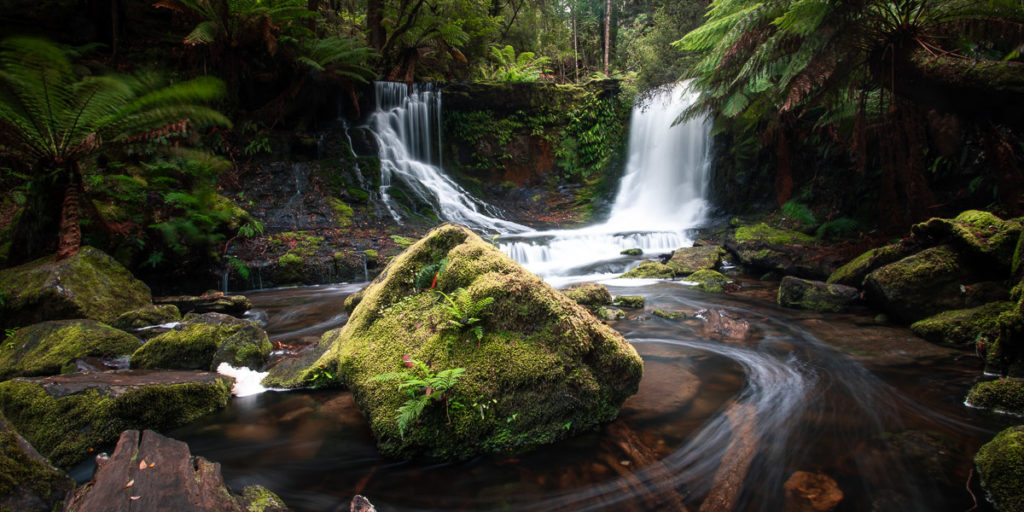
- CPL filters: Circular Polarizing filters reduce glare and increase saturation. If you've ever worn polarized sunglasses, you already know what I'm talking about. I often use CPL filters when shooting over water or if I want to make lush forest greens pop.
Find CP-filters for your lens on Amazon

Peak Design Camera Clip
A camera clip is my personal favorite travel camera accessory. These clips are made by Peak Design and allow you to easily clip your camera on and off your backpack or belt. This is a game-changer for long hikes and outdoor shoots and I honestly couldn't live without it.

Camera Backpack
Of course, you're going to need a camera backpack to store all of your gear.
Recommending the best camera backpack for travel is a difficult task as there are just so many variables to consider. Generally, backpacks are better for travel than sling bags or big pelican cases. That's because are easy to transport, more comfortable and more secure, and discrete for traveling.
Below are my recommendations for camera backpacks based on what I've used and reviews from photographers.
Atlas Packs Adventure Pack My Pack
I recently swapped my everyday photography camera backpack to the Atlas Adventure. I've used a lot of camera backpacks in the past and this is by far the most feature-stacked and comfortable backpack I've ever used.
What I love most is the Origami fold system in the main camera compartment. It negates the need for multiple traditional camera inserts, letting me easily adjust the space to fit different gear setups.
Furthermore, the pack's expandable design is a game-changer. It goes from a carry-on-friendly 35L to a generous 60L, allowing me to fly with all my must-have electronics but still have room for trekking and camping essentials when needed on bigger adventures.
Tip: Atlas also makes a more compact Athlete Pack for the same price.

F-Stop Tilopa 50L Duradiamond
F-stop makes some of the best outdoor camera backpacks in the world. They're tailored for outdoor conditions and are comfortable for long hikes.
The Tilopa has great features with loads of pockets and a huge back-access pocket for all of your gear. The great thing about F-stop backpacks is their modular ICU systems. This means you can change up your backpack depending on whether you need lots of camera gear or more space for clothes and other things.
I was a dedicated user of the F-Stop Tilopa for quite some time before making the switch to the Atlas Pack. Don't get me wrong, the Tilopa served me well and is a solid choice. However, the Atlas Pack edged it out with some additional perks that I couldn't resist—like the innovative origami insert system, adjustable hip belts, and customizable sizing.

WANDRD PRVKE
The PRVKE by WANDRD is a very popular backpack for travel photographers with excellent features if you don't need a dedicated "hiking" or "trekking" pack. What's great about this bag is that it doesn't look like a camera backpack, but still has the accessibility of one.
The PRVKE comes in three sizes; 21L, 31L, and 41L. I've personally tried one on and consider it pretty darn comfortable. However, it's not designed to be a backpack that you take on multi-day hikes in the backcountry.
That said, if you usually shoot street or city travel photography, this backpack offers more than enough features and comfort.

6. A Camera Tripod For Travel
Okay, tripods aren't always necessary for travel photography. However, if you want to step up your landscape photography game, capture time-lapses, or record stable video footage, a great place to start is to invest in a lightweight travel tripod.
At the moment, I'm using the Manfrotto BeFree GT Carbon Fiber tripod. This thing can support 12 kg and weighs less than 1.5 kg. However, I've also been using the HEIPI Travel Tripod as well, especially when weight and size is a factor, like on my recent trip to Island Peak in Nepal.
I've written another comprehensive post on the best lightweight tripods for hiking, backpacking, and travel, that will help you choose the best tripod for your needs.

Technical Camera Terms You'll Need to Learn
Understandably, when starting off with photography, there are a lot of technical terms that are utterly confusing. If you're struggling to choose camera gear for travel because you don't understand what the specs mean, let me help you out with a simple glossary.
- Aperture or f-stop
One of the primary settings in-camera. Aperture is the opening through which light passes through the lens to the sensor. A lower "f-stop" means a larger opening, allowing more light and a shallower depth of field. Lenses with a lower maximum f-stops are considerably more expensive. - Burst rate
Burst rate refers to a camera's maximum number of consecutive photographs that it can shoot before the buffer is full. - Crop sensor (crop factor)
A crop sensor is smaller than the standard 35 mm sensor size (full-frame). Crop sensors capture less light since it is taking in less information in a scene. This means that you will need to purchase lenses that accommodate the sensor size of the "crop factor" of your camera. - Dynamic range
Dynamic range refers to the ratio between the maximum and minimum measurable light intensities. A camera with a higher dynamic range captures more information and allows for more control when editing. - Exposure
Exposure refers to the amount of light captured by the camera's sensor. A common mistake is to severely "underexpose" images (too dark), or "overexpose" them (too bright). Exposure is controlled by the camera's three primary settings, aperture, shutter speed, and ISO. - Focal length
The focal length refers to the distance (in millimeters) between the lens and the sensor. A longer focal length results in a closer (tighter) image, while short focal lengths are used to capture wide scenes. - ISO
ISO is an important setting for digital cameras. The ISO setting determines the camera sensor's sensitivity to light. For example, a low ISO of 100 is good for bright scenes in daylight, while an ISO of 6400 is very sensitive to light and should be used in dark scenes. However, higher ISO sensitivity results in more grain added to the image. Generally speaking, expensive, full-frame cameras allow for a much more acceptable range of ISO to be used without adding too much artificial grain. - IS or OS
IS or OS means image stabilization or optical stabilization. This is a feature in modern cameras and lenses, allowing for smoother video and the ability to shoot hand-held with slower shutter speeds without introducing motion blur. - Prime vs Zoom
This is important when choosing photography equipment for travel. Prime lenses have a fixed (single) focal range, while zoom lenses allow for a range of focal lengths to be used. I recommend choosing good zoom lenses for travel as they are more versatile. - Quality (image quality)
Quality or image quality is a very broad term. When comparing cameras and lenses to purchase, image quality is usually used to determine factors such as dynamic range, exposure, aberrations, information loss, etc. - Resolution
Resolution refers to the megapixels captured by a sensor (dimension). The higher the maximum resolution or megapixels, the more detail photographers get from their images. However, these days you will only notice a difference between cameras with the highest maximum resolution when blowing up the images for large prints. - Shutter speed
Shutter speed is the time in seconds (or fractions of a second) that the sensor is exposed to light in order to capture the image.

Wrapping Up
And that wraps up my comprehensive guide to camera gear for travel. I hope that it has helped you out on your mission to design the ultimate travel photography kit.
My goal is to keep this gear list as relevant and updated as possible to ensure it remains a trustworthy resource for my readers. While you're here, make sure to check out my travel guides for your next travel destination, or head over to the gear guides section for more packing & photography guides.




Pat
Tuesday 21st of February 2023
You should have probably named it something like, "Things I look for in a travel photography kit" as everyone has to deal with the same considerations, but each individual has their own priorities. Yep... you didn't mention any of my favorites! 😁
Olly Gaspar
Tuesday 21st of February 2023
Thanks for the feedback! I've done my best to keep this post as broad as possible to include as many shooting styles as possible. Care to share your favorites?
Rejs Dig Lykkelig
Sunday 18th of September 2022
Thanks for sharing this great guide to camera gear!
Todd
Wednesday 10th of August 2022
I think omitting Fujifilm from your camera recommendations is a significant oversight as they tic all the boxes of what you are looking for in a travel cameta.